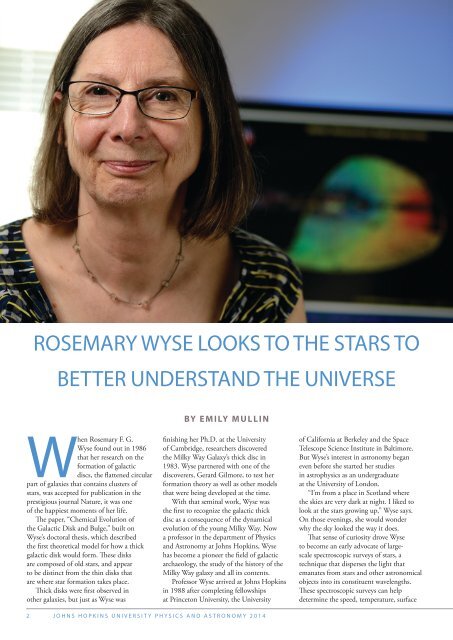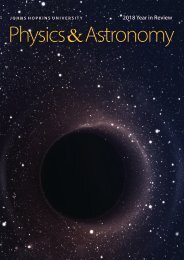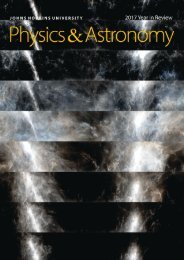2016_PA_Newsletter_12_29_16_FINAL
Create successful ePaper yourself
Turn your PDF publications into a flip-book with our unique Google optimized e-Paper software.
ROSEMARY WYSE LOOKS TO THE STARS TO<br />
BETTER UNDERSTAND THE UNIVERSE<br />
BY EMILY MULLIN<br />
When Rosemary F. G.<br />
Wyse found out in 1986<br />
that her research on the<br />
formation of galactic<br />
discs, the flattened circular<br />
part of galaxies that contains clusters of<br />
stars, was accepted for publication in the<br />
prestigious journal Nature, it was one<br />
of the happiest moments of her life.<br />
The paper, “Chemical Evolution of<br />
the Galactic Disk and Bulge,” built on<br />
Wyse’s doctoral thesis, which described<br />
the first theoretical model for how a thick<br />
galactic disk would form. These disks<br />
are composed of old stars, and appear<br />
to be distinct from the thin disks that<br />
are where star formation takes place.<br />
Thick disks were first observed in<br />
other galaxies, but just as Wyse was<br />
finishing her Ph.D. at the University<br />
of Cambridge, researchers discovered<br />
the Milky Way Galaxy’s thick disc in<br />
1983. Wyse partnered with one of the<br />
discoverers, Gerard Gilmore, to test her<br />
formation theory as well as other models<br />
that were being developed at the time.<br />
With that seminal work, Wyse was<br />
the first to recognize the galactic thick<br />
disc as a consequence of the dynamical<br />
evolution of the young Milky Way. Now<br />
a professor in the department of Physics<br />
and Astronomy at Johns Hopkins, Wyse<br />
has become a pioneer the field of galactic<br />
archaeology, the study of the history of the<br />
Milky Way galaxy and all its contents.<br />
Professor Wyse arrived at Johns Hopkins<br />
in 1988 after completing fellowships<br />
at Princeton University, the University<br />
of California at Berkeley and the Space<br />
Telescope Science Institute in Baltimore.<br />
But Wyse’s interest in astronomy began<br />
even before she started her studies<br />
in astrophysics as an undergraduate<br />
at the University of London.<br />
“I’m from a place in Scotland where<br />
the skies are very dark at night. I liked to<br />
look at the stars growing up,” Wyse says.<br />
On those evenings, she would wonder<br />
why the sky looked the way it does.<br />
That sense of curiosity drove Wyse<br />
to become an early advocate of largescale<br />
spectroscopic surveys of stars, a<br />
technique that disperses the light that<br />
emanates from stars and other astronomical<br />
objects into its constituent wavelengths.<br />
These spectroscopic surveys can help<br />
determine the speed, temperature, surface<br />
2 JOHNS HOPKINS UNIVERSITY PHYSICS AND ASTRONOMY 2014










